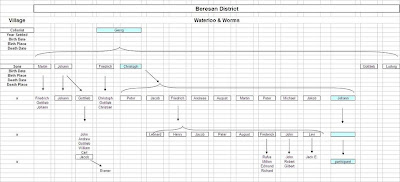GRANDPA JOHN
A Man Possessed With Wanderlust
At the age of eleven, Johannes Sperr began the adventure of a lifetime that would take him across many regions of the world. Johannes was my great, great, great, great grandfather, but I'll call him Grandpa John.
Grandpa John was born on March 8, 1821 in Rielingshausen , Wurttemberg , Germany
In the year 1832, his father Phillipp decided to take advantage of the opportunity to have free land, offered by the Czar of Russia. So John, along with his parents, Phillipp and Margaretha, his older sister, Maria Katharina, his younger brother, Gottlieb and his two younger sisters, Anna Magdelena and Christina, began their trek to South Russia . While their destination was Bessarabia, they stopped in the city of Odessa Bessarabia , founded in 1833. John's father remarried in 1834 and three more sisters and one brother were added to his family.
Because of the lack of land in Friedenstal, the family once again decided to relocate, this time across the Danube River to the province of Dobrudscha Turkey village of Atmagea village of Brienne
After the Russian-Turkish War of 1877-78, Dobrudscha came under Romanian Rule. At age 57, Grandpa John was subject of a fourth country. John and Louisa had three daughters. On of the daughters, Maria Elisabeth, married a newcomer to the area, Samuel Bettcher. Samuel was born in 1857 in Paris , Bessarabia and moved to Atmagea
in 1875 with his family to avoid the conscription into the Russian army. In 1898, John,
who was then widowed, immigrated to the United States Hamburg , Germany
then sailed to New York City
From New York City they took the train to North Dakota Rosenfeld Township , Sheridan County
again set in. Samuel Bettcher, Grandpa John's son-in-law, traveled to both Havana
opportunities appeared best in Canada Saskatchewan , Canada
On September 30, 1912, Grandpa John died at the age of 91. He is buried in the Rosenfeld Cemetery , near Golden Prairie, Saskatchewan




